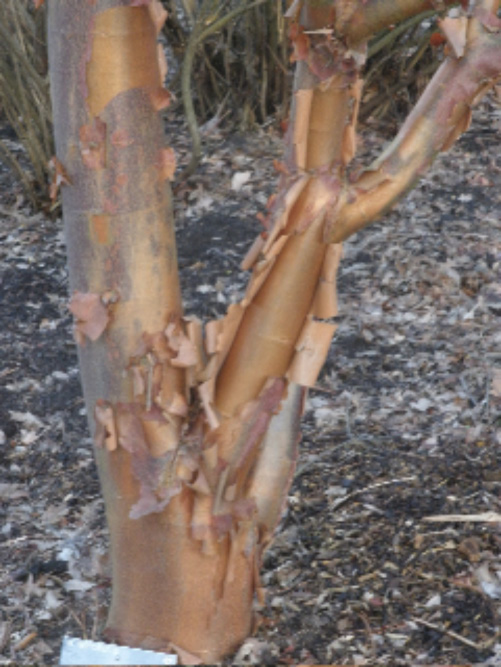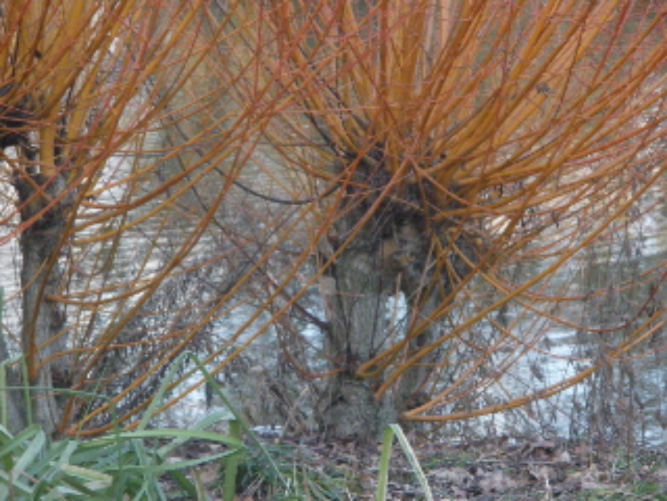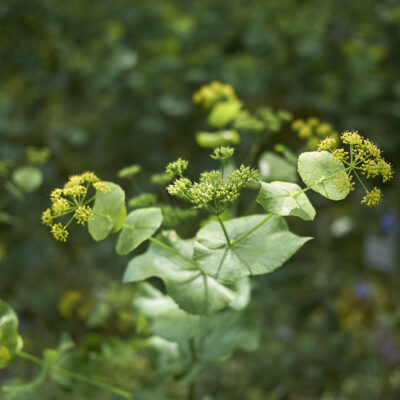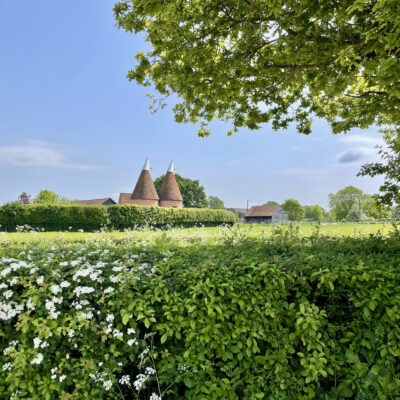Some of us look better naked than others, especially in the winter. It’s the same with plants. Each autumn the deciduous trees and shrubs perform their plant strip-tease, dropping their colourful cloaks (and there are show-offs in that department too) in order to survive the winter. They’ve been standing outside shivering their trunks off for several months now, revealing their intricate and uniquely characteristic skeletons. I love the stark tracery of trees in the winter landscape, but appreciate that dark brown can be a tad monotonous and that (especially now the glitz of Christmas has been put back in its box) we might need a little brightening up. So let me try and tempt you outside to enjoy the wonders of colourful winter bark and stems.
Many acers not only have gorgeous autumn foliage, but glorious bark into the bargain. Acer griseum, the ‘paperbark’ maple, has cinnamon-coloured bark that peels back prettily in translucent bronze flakes. Position so that the sun is behind the trunk and the peeling parts will glow. Acer palmatum ‘Senkaki’ is called the coral-bark maple because it has coral pink stems in winter. There are quite a few with reddish stems and then there are the elegant snake bark maples – A. grosseri is a good one, with green and white striations along its trunk and branches.
Our graceful native silver birch (Betula pendula) has a gleaming white trunk, a beautiful overall shape and is perfectly lovely, but, as ever, horticulturists have improved on nature’s original and there are some birches available with absolutely dazzling white bark. Try B. jacquemontii, B x koehnel or B. albosinensis if you want to blind the neighbours. People (none that I know, fortunately) have been known to scrub the trunks of white barked birches for maximum effect. Please – there’s quite enough washing to do without starting on the trees…
The most tactile tree trunk in my garden is that of Prunus serrula, the ‘birch’ barked cherry, with its lustrous, conker brown bark peeling away in irresistible gleaming strips. It’s also a good all-rounder, with delicate white blossom in the spring and colourful autumn foliage.
I have to admit that I find the curly growth of the corkscrew hazel and willow rather an acquired taste. They both become a bit of an unruly tangle after a few years – and make me think about haircuts and straighteners. Talking of tangles, there’s an interesting plant that does this spectacularly called Rubus cockburnianus. It’s a relative of the bramble and its stems look like a mass of frosted barbed wire – which sounds horrible, but looks amazing, especially in winter sunlight. It takes a brave gardener to plant a bramble in the garden, though, no matter how exciting it is in the winter. Many of the ‘straight’ growing willows have coloured stems too, but I’m hesitating to include them in a list of suitable garden plants, as even when pollarded – pruned to a stump each year, so that only the young (colourful) stems grow, they need to be positioned carefully. Willow has a reputation for being invasive, its roots being hard to dig out once established. I guess the ideal place would be by the side of a pond or stream, where these water seeking trees would naturally grow.
The best group of stunning stems for the garden are in the dogwood family, namely the cultivars Cornus alba ‘Sibirica’ (bright red stems), Cornus sericea ‘Flavirama’ (lime green) and the aptly named C. sanguinea ‘Midwinter Fire’, which, especially if planted in a group, mimics a bonfire in appearance, with pale orange stems that turn to a flaming red nearer the tips. To maintain the stem colour you must hard prune or coppice (cut the stems right back to a stump) each year, as it is the whippy new growth that has the strongest tints. Like the willows, dogwoods prefer moist conditions, but I’ve found that they’ll put up with most types of soil and also mix really well with other border plants. There is a good all rounder in this group that I plant a lot called Cornus alba ‘Elegantissima’. It has deep maroon stems and pretty variegated foliage that turns a buttery yellow in the autumn. It’s not quite so keen on being butchered each year, so I tend to just cut out about a third of the older stems, which also keeps it to a manageable size.
January can be a bleak month, but at the risk of sounding annoyingly chirpy it’s also a great time (choose a crisp day filled with winter sunshine) to go out and visit a fabulous winter garden. So let’s put on our coats and head towards the warm glow of some fiery winter stems.
TEST
 TEST
TEST
 TEST
TEST

- words: Jo Arnell
You may also like
Go with the Flow
Sue Whigham shares some valuable new-to-gardening advice I’m sure that by now we should be used to the rain but I’m not entirely sure that we are. We had a dry, sunny day the other day and how everybody’s mood...
Farm Fables
Jane Howard gets to the bottom of why so many ponds have disappeared across the High Weald I have a new passion, almost an obsession, it’s about ponds. And there’s a distinct possibility I might become a bit of a...
Hedge Issues
Sue Whigham takes a meander along nature’s verdant and vital corridors Recently the BBC’s Today programme carried a feature about England’s hedgerows which created a lot of interest among listeners. On the strength of that, Martha Kearney interviewed one of...















